innogy SE IEKA160 e-mobility controller LSX User Manual
innogy SE e-mobility controller LSX
user manual

LSX
Installation Manual
Manual
Copyright © November 2016 INSYS MICROELECTRONICS GmbH
Any duplication of this manual is prohibited. All rights on this documentation and
the devices are with INSYS MICROELECTRONICS GmbH Regensburg.
Trademarks
The use of a trademark not shown below is not an indication that it is freely availa-
ble for use.
MNP is a registered trademark of Microcom Inc.
IBM PC, AT, XT are registered trademarks of International Business Machine Cor-
poration.
INSYS®, VCom®, e-Mobility LSG® and e-Mobility PLC® are registered trademarks of
INSYS MICROELECTRONICS GmbH.
Windows™ is a registered trademark of Microsoft Corporation.
Linux is a registered trademark of Linus Torvalds.
Publisher:
INSYS MICROELECTRONICS GmbH
Hermann-Köhl-Str. 22
D-93049 Regensburg, Germany
Phone: +49 941 58692 0
Fax: +49 941 58692 45
E-mail: info@insys-icom.com
Internet: http://www.insys-icom.com
Date: Nov-16
Item: -
Version: 1.0
Language: EN

Content
4
Nov-16
1 Preface .................................................................................................. 6
1.1 Defects Liability Terms ........................................................................................ 6
1.2 Feedback ............................................................................................................ 6
1.3 Marking of Warnings and Notes .......................................................................... 7
1.4 Symbols and the Formatting in this Manual ........................................................ 8
2 Safety .................................................................................................... 9
2.1 Intended Use ....................................................................................................... 9
2.2 Permissible Technical Limits.............................................................................. 10
2.3 Responsibilities of the Operator ......................................................................... 10
2.4 Qualification of the Personnel ............................................................................ 10
2.5 Instructions for Transport and Storage .............................................................. 10
2.6 Markings on the Product ................................................................................... 11
2.7 Environmental Protection .................................................................................. 11
2.8 Safety Instructions for Electrical Installation ...................................................... 12
2.9 General Safety Instructions................................................................................ 12
3 Using Open Source Software ............................................................... 14
3.1 General Information .......................................................................................... 14
3.2 Special Liability Regulations .............................................................................. 15
3.3 Used Open-Source Software ............................................................................. 15
4 Technical Information .......................................................................... 16
4.1 Ambient conditions ........................................................................................... 16
4.2 Housing ............................................................................................................ 16
4.3 Connections ...................................................................................................... 16
4.3.1 X1 – Smart card holder ........................................................................... 16
4.3.2 X2 – SIM card holder .............................................................................. 17
4.3.3 X3 – Meter interface 1 (Meter 1) ............................................................ 17
4.3.4 X4 – Meter interface 2 (Meter 2) ............................................................ 18
4.3.5 X5 – Digital outputs ................................................................................ 18
4.3.6 X6 – Digital / analogue inputs ................................................................ 19
4.3.7 X7 – Relay outputs ................................................................................. 21
4.3.8 X8 – GPS antenna ................................................................................... 21
4.3.9 X9 – Cellular antenna ............................................................................. 21
4.3.10 X10 – Serial interface 3 .......................................................................... 22
4.3.11 X12 – WLAN antenna ............................................................................. 22
4.3.12 X13 – Ethernet interface ......................................................................... 23
4.3.13 X14 – Power supply ................................................................................ 23
4.3.14 X15 – GFI connection charging point 1 .................................................. 24
4.3.15 X16 – Connection charging point 1 ........................................................ 25
4.3.16 X17 – GFI connection charging point 2 .................................................. 28
4.3.17 X18 – Connection charging point 1 ........................................................ 29
4.4 Display Elements ............................................................................................... 32
4.5 Reset key .......................................................................................................... 32

Contents
Nov-16 5
5 Assembly ............................................................................................. 33
6 Maintenance, Repair and Troubleshooting ........................................... 36
6.1 Maintenance ..................................................................................................... 36
6.2 Troubleshooting ................................................................................................ 36
6.3 Repair ............................................................................................................... 36
7 Waste Disposal .................................................................................... 37
7.1 Repurchasing of Legacy Systems ...................................................................... 37
8 Declaration of Conformity .................................................................... 38
9 FCC Statement ..................................................................................... 39
10 Export Restriction ................................................................................ 40
11 Tables and Diagrams ............................................................................ 41
11.1 List of Tables ..................................................................................................... 41
11.2 List of Diagrams ................................................................................................ 42
12 Index .................................................................................................... 43

Preface
LSX
6
1 Preface
This manual allows for the safe and efficient use of the product. The manual is part
of the product and must always be stored accessible for installation, commission-
ing and operating personnel.
1.1 Defects Liability Terms
A usage not according to the intended purpose, an ignorance of this documenta-
tion, the use of insufficiently qualified personnel as well as unauthorised modifica-
tions exclude the liability of the manufacturer for damages resulting from this. The
liability of the manufacturer ceases to exist.
The regulations of our Delivery and Purchasing Conditions are effective. These can
be found on our website (www.insys-icom.de/imprint/) under “General Terms and
Conditions“.
1.2 Feedback
We are permanently improving our products and the associated technical docu-
mentation. Your feedback is very helpful for this. Please tell us what you like in par-
ticular on our products and publications and what can be improved from your point
of view. We highly appreciate your suggestions and will include them in our work
to support you and all our customers. We are looking forward to any of your feed-
back.
Please send an e-mail to support@insys-tec.de.
We'd like to know your applications. Please send us a few headwords that we
know the applications you solve using products of INSYS icom.
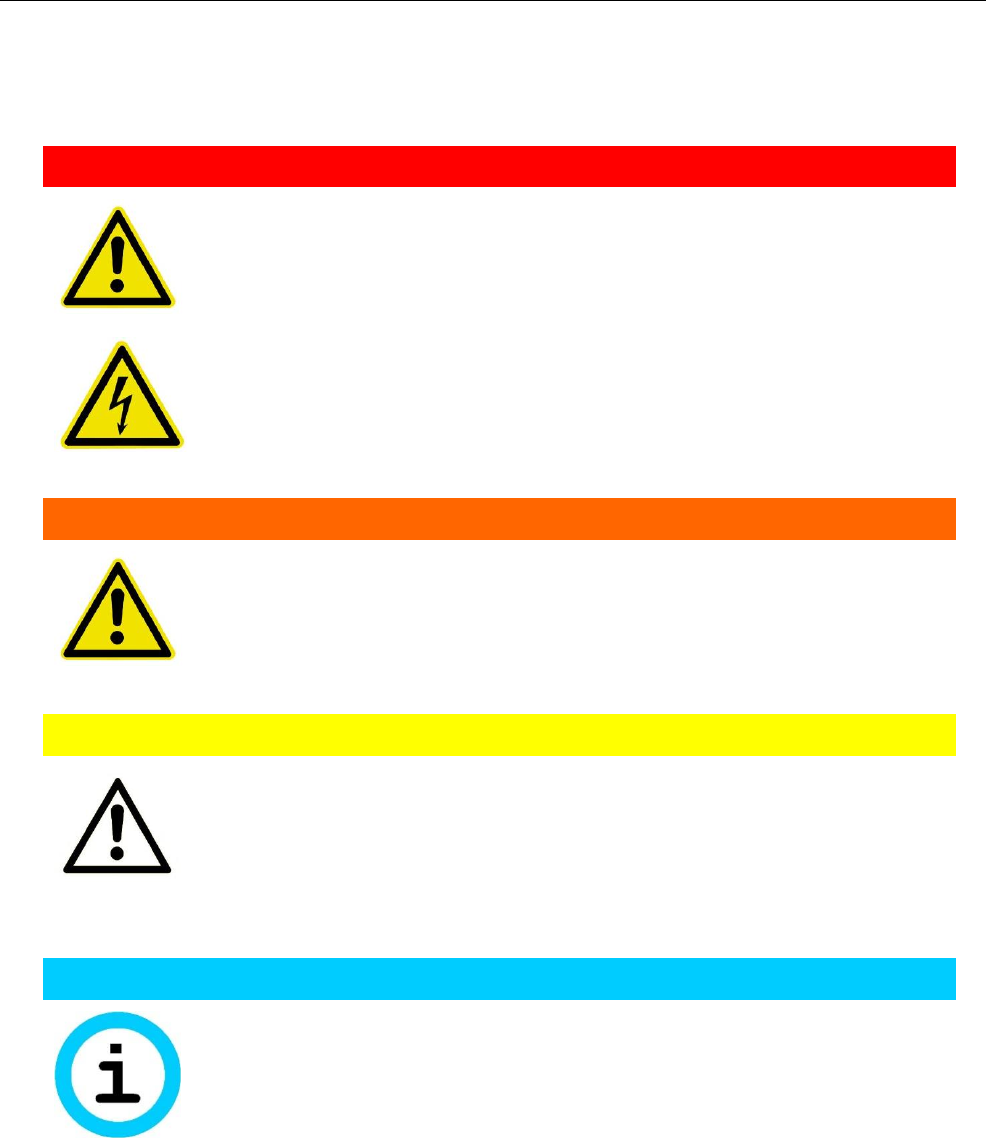
LSX
Preface
7
1.3 Marking of Warnings and Notes
Symbols and Key Words
Danger!
Risk of severe or fatal injury
One of these symbols in conjunction with the key word
Danger indicates an imminent danger. It will cause death
or severe injuries if not avoided.
Warning!
Personal injury
This symbol in conjunction with the key word Warning
indicates a possibly hazardous situation. It might cause
death or severe injuries if not avoided.
Caution!
Slight injury and / or material damage
This symbol in conjunction with the key word Caution
indicates a possibly hazardous or harmful situation. It
might cause slight or minor injuries or a damage of the
product or something in its vicinity if not avoided.
Note
Improvement of the application
This symbol in conjunction with the key word Note
indicates hints for the user or very useful information. This
information helps with installation, set-up and operation of
the product to ensure a fault-free operation.

Preface
LSX
8
1.4 Symbols and the Formatting in this Manual
This section describes the definition, formatting and symbols used in this manual.
The various symbols are meant to help you read and find the information relevant
to you. The following text is structured like a typical operating instruction of this
manual.
Bold print: This will tell you what the following steps will result in
After that, there will be a detailed explanation why you could perform the
following steps to be able to reach the objective indicated first. You can
decide whether the section is relevant for you or not.
An arrow will indicate prerequisites which must be fulfilled to be able to
process the subsequent steps in a meaningful way. You will also learn
which software or which equipment you will need.
1. One individual action step: This tells you what you need to do at this
point. The steps are numbered for better orientation.
A result which you will receive after performing a step will be marked
with a check mark. At this point, you can check if the previous steps
were successful.
Additional information which you should consider are marked with a
circled "i". At this point, we will indicate possible error sources and tell
you how to avoid them.
Alternative results and steps are marked with an arrow. This will tell
you how to reach the same results performing different steps, or what
you could do if you didn't reach the expected results at this point.

LSX
Safety
9
2 Safety
The Safety section provides an overview about the safety instructions, which must
be observed for the operation of the product.
The product is constructed according to the currently valid state-of-the-art technol-
ogy and reliable in operation. It has been checked and left the factory in flawless
condition concerning safety. In order to maintain this condition during the service
life, the instructions of the valid publications and certificates must be observed and
followed.
It is necessary to adhere to the general safety instructions must when operating the
product. The descriptions of processes and operation procedures are provided with
precise safety instructions in the respective sections in addition to the general
safety instructions.
Moreover, the local accident prevention regulations and general safety regulations
for the operating conditions of the device are effective.
An optimum protection of the personnel and the environment from hazards as well
as a safe and fault-free operation of the product is only possible if all safety instruc-
tions are observed.
2.1 Intended Use
The product may only be used for the purposes specified in the function overview.
In addition, it may be used for the following purposes:
Usage and installation as controller in an AC charging station or AC
wall box for electric vehicles
The product may not be used for the following purposes and used or operated un-
der the following conditions:
Controlling or switching of machines and systems, which do not
comply with the directive 2006/42/EC.
Usage, controlling, switching and data transmission of machines and
systems, which are operated in explosive atmospheres.
Controlling, switching and data transmission of machines, which may
involve risks to life and limb due to their functions or when a
breakdown occurs.

Safety
LSX
10
2.2 Permissible Technical Limits
The product is only intended for the use within the permissible technical limits
specified in the data sheets.
The following permissible limits must be observed:
The ambient temperature limits must not be fallen below or
exceeded.
The supply voltage range must not be fallen below or exceeded.
The maximum humidity must not be exceeded and condensate
formation must be prevented.
The maximum switching voltage and the maximum switching current
load must not be exceeded.
The maximum input voltage and the maximum input current must not
be exceeded.
2.3 Responsibilities of the Operator
As a matter of principle, the operator must observe the legal regulations, which are
valid in his country, concerning operation, functional test, repair and maintenance
of electrical devices.
2.4 Qualification of the Personnel
The installation, commissioning and maintenance of the product must only be per-
formed by trained expert personnel, which has been authorised by the plant opera-
tor. The expert personnel must have read and understood this documentation and
observe the instructions.
Electrical connection and commissioning must only be performed by a person, who
is able to work on electrical installations and identify and avoid possible hazards in-
dependently, based on professional training, knowledge and experience as well as
knowledge of the relevant standards and regulations.
2.5 Instructions for Transport and Storage
The following instructions must be observed:
Do not expose the product to moisture and other potential hazardous
environmental conditions (radiation, gases, etc.) during transport and
storage. Pack product accordingly.
Pack product sufficiently to protect it against shocks during transport
and storage, e.g. using air-cushioned packing material.
Check product for possible damages, which might have been caused by improper
transport, before installation. Transport damages must be noted down to the ship-
ping documents. All claims or damages must be filed immediately and before in-
stallation against the carrier or party responsible for the storage.
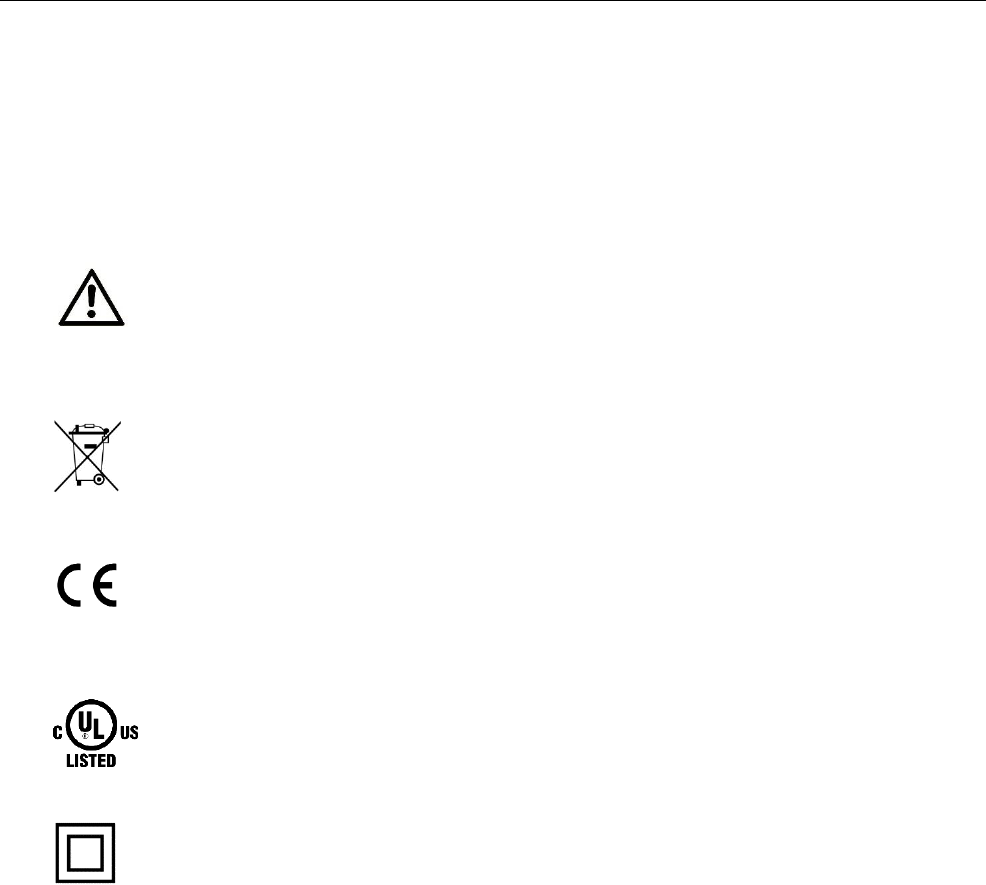
LSX
Safety
11
2.6 Markings on the Product
The identification plate of the product is either a print or a label on a face of the
product. Amongst other things, it can contain the following markings, which are
explained in detail here.
Observe manual
This symbol indicates that the manual of the product contains
essential safety instructions that must be followed implicitly.
Dispose waste electronic equipment environmentally
compatible
This symbol indicates that waste electronic equipment must be
disposed separately from residual waste via appropriate collecting
points. See also Section Disposal in this manual.
CE marking
By applying a CE marking, the manufacturer confirms that the
product complies with the European directives that apply product-
specific.
UL marking
By applying a UL marking, the manufacturer confirms that the
product complies with the obligatory safety requirements.
Appliance Class II - double insulated
This symbol indicates that the product complies with Appliance
Class II
2.7 Environmental Protection
Dispose the product and the packaging according to the relevant environmental
protection regulations. The Waste Disposal section in this manual contains notes
about disposing the product. Separate the packaging components of cardboard
and paper as well as plastic and deliver them to the respective collection systems
for recycling.
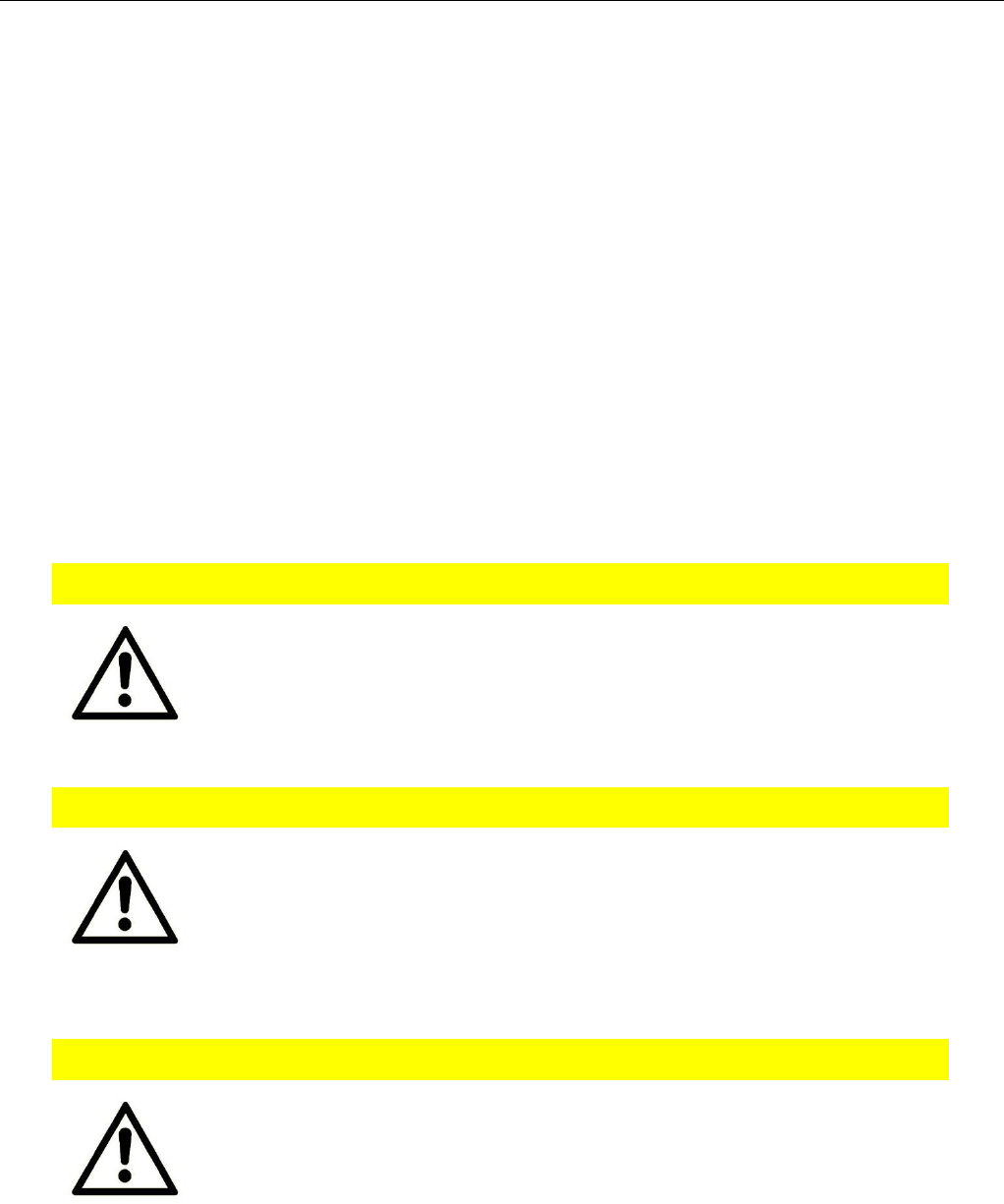
Safety
LSX
12
2.8 Safety Instructions for Electrical Installation
The electrical connection must only be made by authorised expert personnel ac-
cording to the wiring diagrams.
The notes to the electrical connection in the manual must be observed. Otherwise,
the protection category might be affected.
The safe disconnection of circuits, which are hazardous when touched, is only en-
sured if the connected devices meet the requirements of VDE T.101 (Basic require-
ments for safe disconnection).
The supply lines are to be routed apart from circuits, which are hazardous when
touched, or isolated additionally for a safe disconnection.
An easily accessible isolation device that disconnects all lines must be installed
prior to commissioning of the device to be able to isolate it completely from power
supply.
2.9 General Safety Instructions
Caution!
Electrostatic discharges may damage the product!
Damage of the product.
Observe the general safety precautions when handling
electrostatic-discharge-sensitive parts.
Caution!
Incomplete voltage isolation!
Damage of the product.
To isolate the voltage from the device, disconnect any
supply circuit with its respective isolation device if a
redundant power supply is used.
Caution!
Moisture and liquids from the environment may seep into
the interior of the product!
Fire hazard and damage of the product.
The product must not be used in wet or damp
environments, or in the direct vicinity of water. Install the
product at a dry location, protected from water spray.
Disconnect the power supply before you perform any work
on a device which may have been in contact with
moisture.
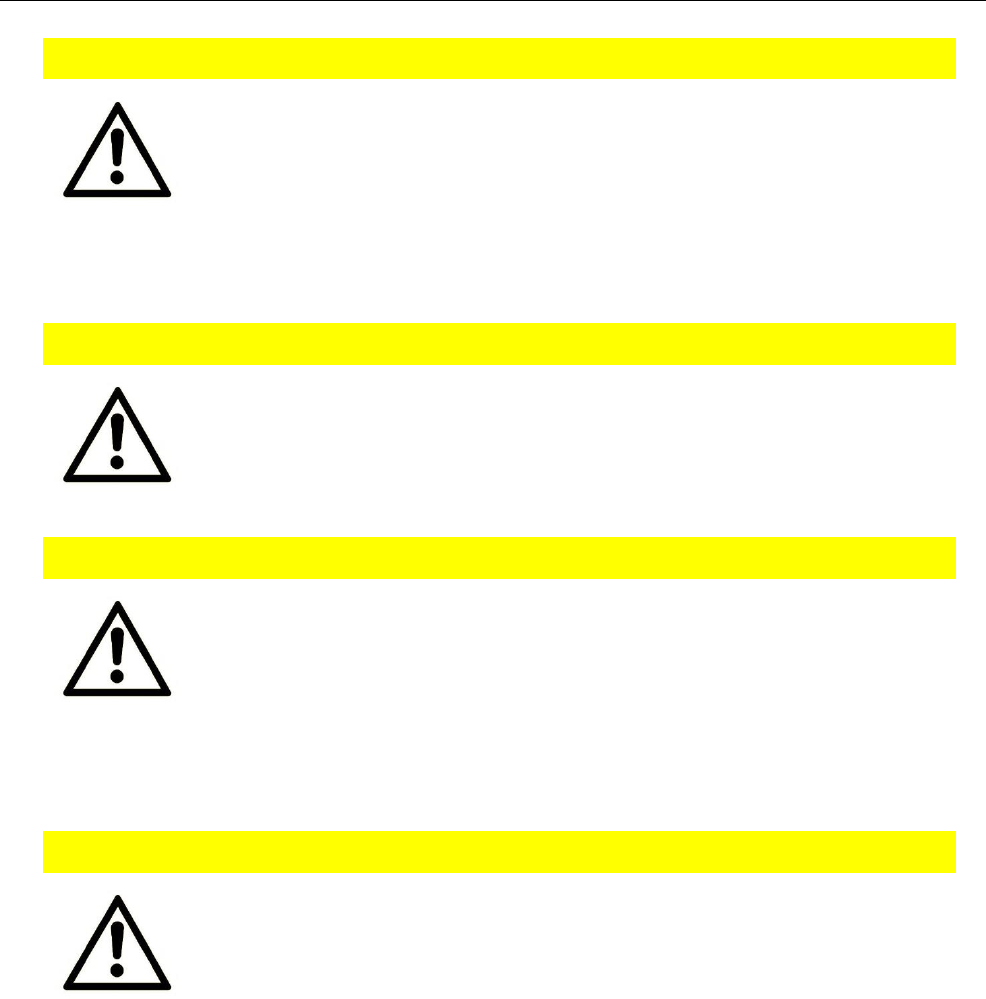
LSX
Safety
13
Caution!
Short circuits and damage due to improper repairs and
modifications as well as opening of maintenance areas!
Fire hazard and damage of the product.
It is not permitted to open the product for repair or
modification exceeding the removal or installation of the
designated plug-in cards.
Caution!
Overvoltage and voltage peaks from the mains supply!
Fire hazard and damage of the product due to overvoltage.
Install suitable overvoltage protection.
Caution!
Damage due to chemicals!
Ketones and chlorinated hydrocarbons dissolve the plastic
housing and damage the surface of the device.
Never let the device come into contact with ketones (e.g.
acetone) or chlorinated hydrocarbons, such as
dichloromethane.
Caution!
Distance from antennas to persons!
A too low distance from cellular antennas to persons can
affect the health.
Please observe to keep a minimum distance of 20 cm
between the cellular antenna and persons during
operation.
Important note for installations in Sweden or Norway:
Utrustning som är kopplad till skyddsjord via jordat vägguttag och/eller
via annan utrustning och samtidigt är kopplad till kabel-TV nät kan I
visa fall medföra risk fr brand. För att undvika detta skall vid anslutning
av utrustningen till kabel-TV nät galvanisk isolator finnas mellan
utrustningen och kabel-TV nätet.

Using Open Source Software
LSX
14
3 Using Open Source Software
3.1 General Information
Our product LSX contains, amongst others, so-called open-source software that is
provided by third parties and has been published for free public use. The open-
source software is subject to special open-source software licenses and the copy-
right of third parties. Basically, each customer can use the open-source software
freely in compliance with the licensing terms of the respective producers. The
rights of the customer to use the open-source software beyond the purpose of our
product are regulated in detail by the respective concerned open-source software
licenses. The customer use the open-source software freely, as provided in the re-
spective effective license, beyond the purpose that the open-source software gets
in our product. In case there is a contradiction between the licensing terms for our
product and the respective open-source software license, the respective relevant
open-source software license takes priority over our licensing terms, as far as the
respective open-source software is concerned by this.
The use of the used open-source software is possible free of charge. We do not de-
mand usage fees or any comparable fees for the use of the open-source software
contained in our product. The use of the open-source software in our product by
the customer is not part of the earnings we achieve with the contractual compen-
sation.
All open-source software programs contained in our product can be taken from the
available list. The most important open-source software licenses are listed in the Li-
censes section at the end of this publication.
As far as programs contained in our product are subject to the GNU General Public
License (GPL), GNU Lesser General Public License (LGPL), Clarified Artistic License
or another open-source software license, which regulates that the source code
must be made available, and if this software is not already delivered in source code
on a data carrier with our product, we will send you this at any time upon request.
If it is required to send this on a data carrier, the sending will be made against pay-
ment of a cost compensation of € 10,00. Our offer to send the source code upon
request ceases automatically 3 years after delivery of our product to the customer.
Requests must be directed to the following address, if possible under specification
of the serial number:
INSYS MICROELECTRONICS GmbH
Hermann-Köhl-Str. 22
93049 Regensburg, Germany
Phone +49 941 58692 0
Fax +49 941 58692 45
E-mail: support@insys-icom.de

LSX
Using Open Source Software
15
3.2 Special Liability Regulations
We do not assume any warranty or liability, if the open-source software programs
contained in our product are used by the customer in a manner that does not com-
ply any more with the purpose of the contract, which is the basis of the acquisition
of our product. This concerns in particular any use of the open-source software
programs outside of our product. The warranty and liability regulations that are pro-
vided by the respective effective open-source software license for the respective
open-source software as listed in the following are effective for the use of the
open-source software beyond the purpose of the contract. In particular, we are not
liable, if the open-source software in our product or the complete software configu-
ration in our product is changed. The warranty granted with the contract, which is
the basis of the acquisition of our product, is only effective for the unchanged
open-source software and the unchanged software configuration in our product.
3.3 Used Open-Source Software
Please contact our support department (support@insys-icom.de) for a list of the
open-source software used in this product.

Technical Information
LSX
16
4 Technical Information
All specified data was measured with an input voltage of 12 V, at full load, and an
ambient temperature of 25 ℃. The limit value tolerances are subject to the usual
variations.
4.1 Ambient conditions
Property
Value
Temperature range
-30 °C … 65 °C
Maximum permissible humidity
95% non-condensing
Table 1: Technical Information - ambient conditions
4.2 Housing
The housing is to be mounted horizontally to a DIN rail. Thermal conditions must be
considered.
Property
Value
Weight
380 g
Dimensions (width x height x depth)
161 mm x 91 mm x 62 mm
without connectors, plugs and DIN rail
clip
IP rating
Housing IP30
Connector IP20
Table 2: Technical Information - housing
4.3 Connections
4.3.1 X1 – Smart card holder
The smart card will be inserted in holder X1. It will be ejected by pressing with a
pointed tool (e.g. ball pen). There is no protection against removal of an inserted
card.
Property
Value
Format
ISO 7816 ID-000 (25x15 mm)
conforms to Mini-SIM (2FF)
locked
Table 3: Technical Information – smart card holder
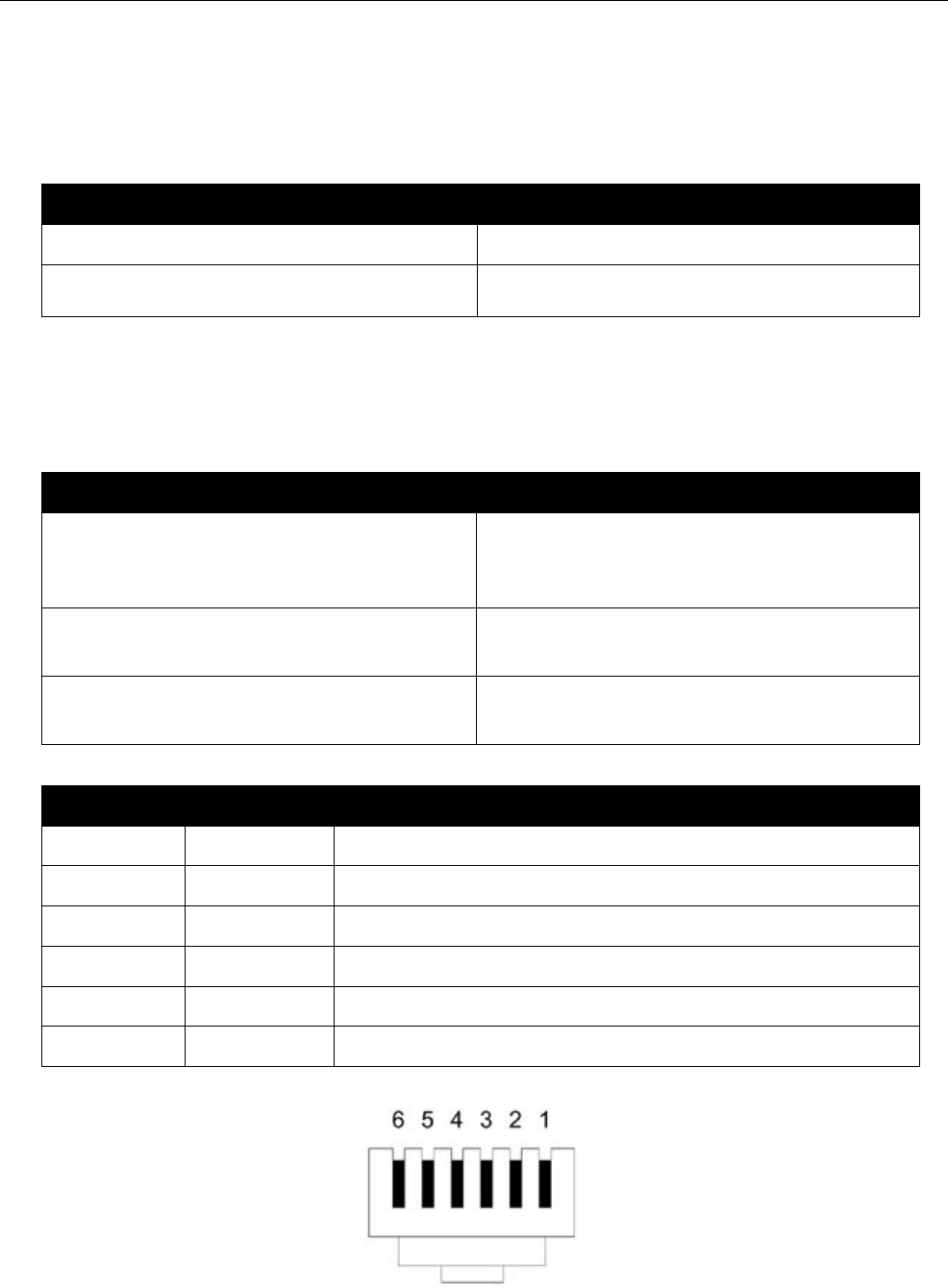
LSX
Technical Information
17
4.3.2 X2 – SIM card holder
The SIM card will be inserted in holder X2. It will be ejected by pressing with a
pointed tool (e.g. ball pen). There is no protection against removal of an inserted
card.
Property
Value
Supports
1.8 V and 3.0 V SIM cards
Format
Mini-SIM (2FF)
locked
Table 4: Technical Information – SIM card holder
4.3.3 X3 – Meter interface 1 (Meter 1)
Connection of the meter Meter 1 takes place using socket X3.
Property
Value
Type
RJ12 (6p6c)
unshielded
not isolated
RS232
Max. baud rate 115.200 bit/s
Level according to V.28
RS485
Max. baud rate 921.600 bit/s
Level according to EIA 485
Table 5: Technical Information – Meter interface 1 (Meter 1)
Terminal
Signal
Description
1
RS485+
RS485 Data -
2
Supply
Power supply
3
GND
GND (ground)
4
RS232 TxD
RS232 TxD (output)
5
RS232 RxD
RS232 RxD (input)
6
RS485+
RS485 Data +
Table 6: Terminal X3 – Meter interface 1 (Meter 1)
Figure 1: Terminal X3 – Meter interface 1 (Meter 1) (view on plug)
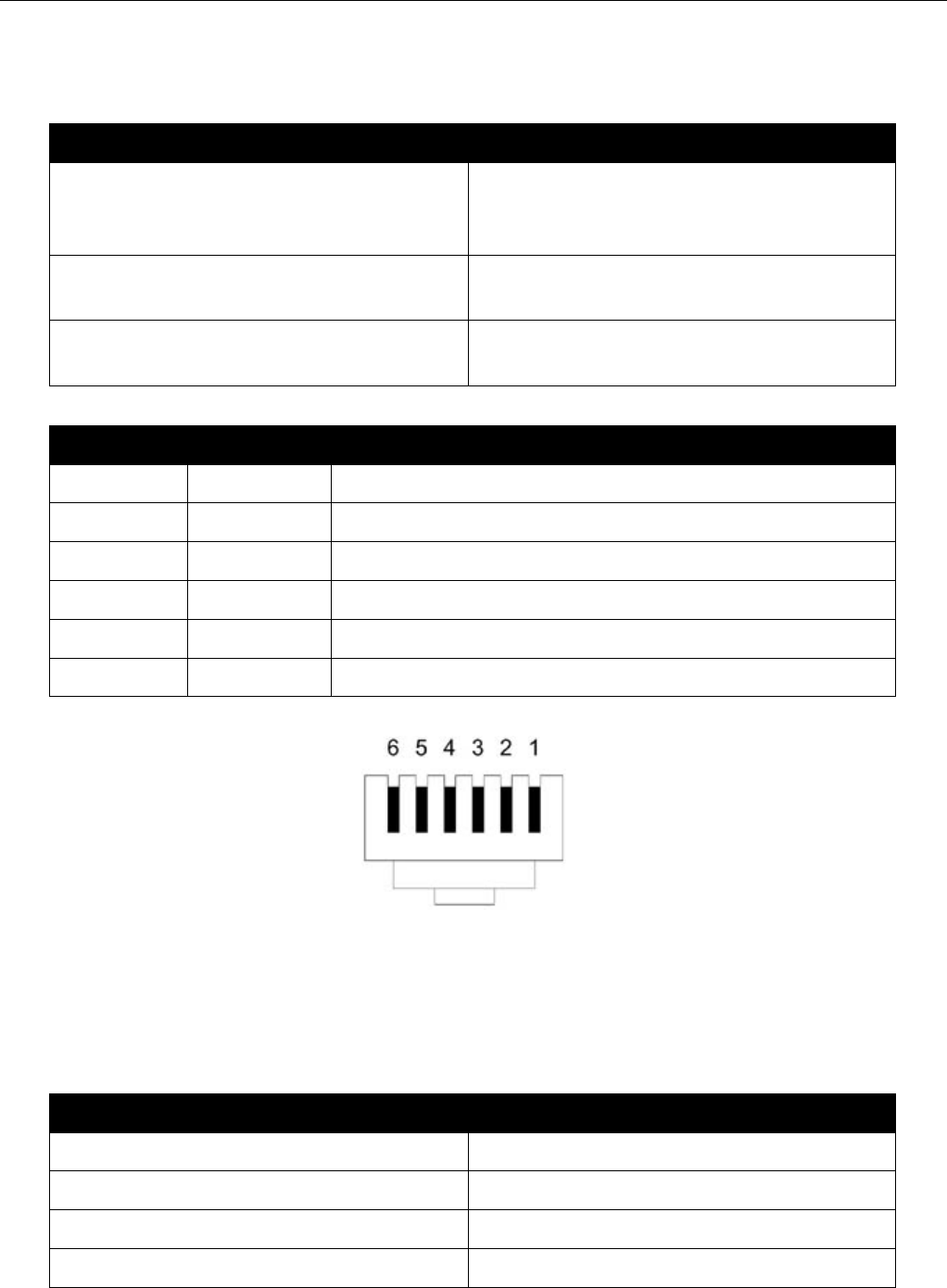
Technical Information
LSX
18
4.3.4 X4 – Meter interface 2 (Meter 2)
Connection of the meter Meter 2 takes place using socket X4.
Property
Value
Type
RJ12 (6p6c)
unshielded
not isolated
RS232
Max. baud rate 115.200 bit/s
Level according to V.28
RS485
Max. baud rate 921.600 bit/s
Level according to EIA 485
Table 7: Technical Information – Meter interface 2 (Meter 2)
Terminal
Signal
Description
1
RS485+
RS485 Data -
2
Supply
Power supply
3
GND
GND (ground)
4
RS232 TxD
RS232 TxD (output)
5
RS232 RxD
RS232 RxD (input)
6
RS485+
RS485 Data +
Table 8: Terminal X4 – Meter interface 2 (Meter 2)
Figure 2: Terminal X4 – Meter interface 2 (Meter 2) (view on plug)
4.3.5 X5 – Digital outputs
Connection of the digital outputs takes place using connector X5. The digital out-
puts comprise isolated outputs and contact outputs that switch to GND.
Property
Value
Execution
Transistor
Switch current
max. 20 mA
Switch voltage
max. 30 V
Voltage drop in ON condition
< 1.5 V at 20 mA
Table 9: Technical Information – Isolated outputs

LSX
Technical Information
19
Property
Value
Execution
Open-drain
Continuous current
max. 0.5 A
Short-time current (<1 s)
5 A
Electric strength
30 V
Table 10: Technical Information - Contact outputs
Terminal
Signal
Description
1
DO1+
Isolated output 1, +
2
DO1-
Isolated output 1, -
3
DO2+
Isolated output 2, +
4
DO2-
Isolated output 2, -
5
CO1
Contact output 1 (switches to GND)
6
CO2
Contact output 2 (switches to GND)
Table 11: Terminal X5 – Digital outputs
Wire
Cross-section
Nominal cross-section
1.5 mm²
Rigid
0.2 – 1.5 mm²
Flexible
0.2 – 1.5 mm²
Flexible with end sleeve
0.25 – 1.5 mm²
Table 12: Terminal X5 – Permissible wire cross-sections
4.3.6 X6 – Digital / analogue inputs
Connection of the digital and analogue inputs takes place using connector X6. The
digital inputs comprise isolated inputs and contact inputs.
Property
Value
Execution
Optoelectronic coupler
LOW level
< 4 V DC
HIGH level
10 … 30 V DC
Input current
max. 2 mA at 30 V DC
Table 13: Technical Information – Isolated inputs

Technical Information
LSX
20
Property
Value
Execution
Contact to GND
Power supply
internal pull-up resistor
10 kOhm at 3.3 V DC
LOW level
0 … 0.5 V DC
HIGH level
1.5 … 3.3 V DC
External voltage resistance
-5 … 30 V DC
Table 14: Technical Information - Contact inputs
Property
Value
Execution
Analogue
Voltage range
0 … 10 V DC
Accuracy
+/-3%
Resolution
10 bit
Input resistance
approx. 30 kOhm
External voltage resistance
-5 … 30 V DC
Table 15: Technical Information - Analogue inputs
Terminal
Signal
Description
1
DI1+
Isolated input 1, +
2
DI1-
Isolated input 1, -
3
DI2+
Isolated input 2, +
4
DI2-
Isolated input 2, -
5
CI1
Contact input 1 (contact to GND)
6
CI2
Contact input 2 (contact to GND)
7
AGND
Reference potential for analogue inputs
8
AI1
Analogue input 1
9
AI2
Analogue input 2
10
AI3
Analogue input 3
Table 16: Terminal X6 – Digital / analogue inputs
Wire
Cross-section
Nominal cross-section
1.5 mm²
Rigid
0.2 – 1.5 mm²
Flexible
0.2 – 1.5 mm²
Flexible with end sleeve
0.25 – 1.5 mm²
Table 17: Terminal X6 – Permissible wire cross-sections

LSX
Technical Information
21
4.3.7 X7 – Relay outputs
Connection of the relay outputs takes place using connector X7.
Property
Value
Execution
Relay, monostable
Switching capacity NO
max. 3 A / 30 V DC
Switching capacity NC
max. 2 A / 30 V DC
Minimum contact load
5 V / 100 mA
Table 18: Technical Information – Relay outputs
Terminal
Signal
Description
1
OUT1-NC
Relay 1, normally closed (NC)
2
OUT1
Relay 1, center contact
3
OUT1-NO
Relay 1, normally open (NO)
4
OUT2-NC
Relay 2, normally closed (NC)
5
OUT2
Relay 2, center contact
6
OUT2-NO
Relay 2, normally open (NO)
Table 19: Terminal X7 – Relay outputs
Wire
Cross-section
Nominal cross-section
1.5 mm²
Rigid
0.2 – 1.5 mm²
Flexible
0.2 – 1.5 mm²
Flexible with end sleeve
0.25 – 1.5 mm²
Table 20: Terminal X7 – Permissible wire cross-sections
4.3.8 X8 – GPS antenna
Connection of the GPS antenna takes place using connector X8.
Property
Value
Type
SMA
Phantom power
approx. 4 V / 50 mA
Table 21: Technical Information – GPS antenna connection
4.3.9 X9 – Cellular antenna
Connection of the cellular antenna takes place using connector X9.
Property
Value
Type
SMA
Table 22: Technical Information – Cellular antenna connection

Technical Information
LSX
22
4.3.10 X10 – Serial interface 3
Connection of the serial interface 3 takes place using socket X10. Serial interface 3
has two independent RS232 interfaces that are directly connected to the CPU.
Property
Value
Type
RJ12 (6p6c)
unshielded
not isolated
RS232
Max. baud rate 115.200 bit/s
Level according to V.28
Table 23: Technical Information – Serial interface 3
Terminal
Signal
Description
1
RS232 TxD 1
RS232 TxD (output) 1
2
RS232 RxD 1
RS232 RxD (input) 1
3
GND
GND (ground)
4
RS232 TxD 2
RS232 TxD (output) 2
5
RS232 RxD 2
RS232 RxD (input) 2
6
GND
GND (ground)
Table 24: Terminal X10 – Serial interface 3
Figure 3: Terminal X10 – Serial interface 3 (view on plug)
4.3.11 X12 – WLAN antenna
Connection of the WLAN antenna takes place using connector X12.
Property
Value
Type
Reverse SMA
Table 25: Technical Information – WLAN antenna connection

LSX
Technical Information
23
4.3.12 X13 – Ethernet interface
The Ethernet interface is on Ethernet connection X13. Ethernet connection X13
comprises 2 Ethernet interfaces, Ethernet interface X13a and the 3-port switch
X13b.
Property
Value
Type
4x RJ45
shielded
Ethernet
10/100 Mbit/s full/half duplex auto
sense; automatic detection of
"crossover" or "patch" wiring.
Table 26: Technical Information – Ethernet interface
4.3.13 X14 – Power supply
Connection of the power supply takes place using connector X14.
Property
Value
Operating voltage
12 V … 24 V DC (±20%)
Power consumption
< 15 W under full load
< 6 W under reduced operation (idle)
IP rating
Housing IP30, connector IP20
Table 27: Technical Information – Power supply
Terminal
Signal
Description
1
-
Ground
2
+
Power supply
Table 28: Terminal X14 – Power supply
Wire
Cross-section
Nominal cross-section
2.5 mm²
Rigid
0.2 – 2.5 mm²
Flexible
0.2 – 2.5 mm²
Flexible with end sleeve
0.25 – 2.5 mm²
Table 29: Terminal X14 – Permissible wire cross-sections
According to the requirement of IEC 61851 (Ed. 3 CDV), voltages (ELV) between
EVSE and EV must be isolated from the grid using transformers that comply with
the requirements according to IEC 61558-1 and -2-4. This must apply to the supply-
ing power supply unit in the charging station. Use limited power source (LPS) acc.
UL/IEC 60950-1 or UL/IEC 62368-1 only.

Technical Information
LSX
24
4.3.14 X15 – GFI connection charging point 1
GFI connection for charging point 1 takes place using socket X15.
Property
Value
Socket
Molex MicroFit 43045-0601
Table 30: Technical Information – GFI connection charging point 1
Property
Value
Signal
GFI_Preset
Execution
Open collector output (to GND)
Load
max. 12 V DC at 25 mA
Voltage drop condition 1
max. 1 V DC at 10 mA
Leakage current condition 0
> 50 mA
Table 31: Technical Information – GFI connection charging point 1 – GFI_Preset
Property
Value
Signal
GFI_Activate
Execution
Open collector output (to GND)
Load
max. 12 V DC at 25 mA
Voltage drop condition 1
max. 1 V DC at 10 mA
Leakage current condition 0
> 50 mA
Table 32: Technical Information – GFI connection charging point 1 – GFI_Activate
Property
Value
Signal
GFI_Status
Execution
Contact input (to GND)
Load external driver/contact
max. 12 V DC at 10 mA
HIGH level
>= 1.5 V DC
Leakage current condition 0
> 50 µA
Table 33: Technical Information – GFI connection charging point 1 – GFI_Status
Property
Value
Signal
GFI_Welding
Execution
Contact input (to GND)
Load external driver/contact
max. 12 V DC at 10 mA
HIGH level
>= 1.5 V DC
Leakage current condition 0
> 50 µA
Table 34: Technical Information – GFI connection charging point 1 – GFI_Welding

LSX
Technical Information
25
Property
Value
Signal
GFI_VoltageMonitor
Execution
Contact input (to GND)
Load external driver/contact
max. 12 V DC at 10 mA
HIGH level
>= 1.5 V DC
Leakage current condition 0
> 50 µA
Table 35: Technical Information – GFI connection charging point 1 – GFI_VoltageMonitor
Terminal
Signal
Description
1
GFI_Preset (OUT)
2
GND
GND (ground)
3
GFI_Activate (OUT)
4
GFI_Status (IN)
5
GFI_Welding (IN)
6
GFI_VoltageMonitor (IN)
Table 36: Terminal X15 – GFI connection charging point 1
4.3.15 X16 – Connection charging point 1
Connection for charging point 1 takes place using socket X16.
Property
Value
Signal
Interlock feedback
Execution
Contact input (to GND)
Power supply
internal pull-up resistor
10 kOhm at 15 V DC
LOW level
0 … 1.5 V DC
HIGH level
4.5 … 15 V DC
External voltage resistance
-5 … 30 V DC
Table 37: Technical Information – Connection charging point 1 – Interlock feedback

Technical Information
LSX
26
Property
Value
Signal
Voltage monitor
Execution
Contact input (to GND)
Power supply
internal pull-up resistor
10 kOhm at 5 V DC
LOW level
0 … 1 V DC
HIGH level
3.5 … 5 V DC
External voltage resistance
-5 … 30 V DC
Table 38: Technical Information – Connection charging point 1 – Voltage monitor
Property
Value
Signal
Proximity
Execution
Analogue input
Voltage range
0 … 5 V DC
Accuracy
+/-5%
Resolution
10 bit
External voltage resistance
0 … 5 V DC or max. 100 mA
Table 39: Technical Information – Connection charging point 1 – Proximity
Property
Value
Signal
Contactor
Execution
Open drain output (to GND)
Continuous current
max. 1 A
Short-time current (<1 s)
5 A
Electric strength
30 V
Table 40: Technical Information – Connection charging point 1 – Contactor
Property
Value
Signal
Operating current trigger
Execution
Open drain output (to GND)
Continuous current
max. 1 A
Short-time current (<1 s)
5 A
Electric strength
30 V
Table 41: Technical Information – Connection charging point 1 – Operating current trigger

LSX
Technical Information
27
Property
Value
Signal
Interlock
Execution
Relay, monostable
Switching capacity NO
max. 3 A / 30 V DC
Switching capacity NC
max. 2 A / 30 V DC
Minimum contact load
5 V / 100 mA
Table 42: Technical Information – Connection charging point 1 – Interlock
Property
Value
Signal
PT1000
Execution
2-wire
Accuracy
+/-5°C
Table 43: Technical Information – Connection charging point 1 – PT1000
Terminal
Signal
Description
1
Interlock feedback (IN)
2
Voltage monitor (IN)
3
Control pilot -
4
Control pilot +
5
Proximity (IN)
6
Contactor (OUT), switches to GND
7
Operating current trigger (OUT), switches to GND
8
Interlock, relay, normally open contact (NO)
9
Interlock, relay, center contact
10
Interlock, relay, normally closed contact (NC)
11
PT1000 - (GND)
12
PT1000 +
Table 44: Terminal X16 – Connection charging point 1
Wire
Cross-section
Nominal cross-section
1.5 mm²
Rigid
0.2 – 1.5 mm²
Flexible
0.2 – 1.5 mm²
Flexible with end sleeve
0.25 – 1.5 mm²
Table 45: Terminal X16 – Permissible wire cross-sections

Technical Information
LSX
28
4.3.16 X17 – GFI connection charging point 2
GFI connection for charging point 2 takes place using socket X17.
Property
Value
Socket
Molex MicroFit 43045-0601
Table 46: Technical Information – GFI connection charging point 2
Property
Value
Signal
GFI_Preset
Execution
Open collector output (to GND)
Load
max. 12 V DC at 25 mA
Voltage drop condition 1
max. 1 V DC at 10 mA
Leakage current condition 0
> 50 mA
Table 47: Technical Information – GFI connection charging point 2 – GFI_Preset
Property
Value
Signal
GFI_Activate
Execution
Open collector output (to GND)
Load
max. 12 V DC at 25 mA
Voltage drop condition 1
max. 1 V DC at 10 mA
Leakage current condition 0
> 50 mA
Table 48: Technical Information – GFI connection charging point 2 – GFI_Activate
Property
Value
Signal
GFI_Status
Execution
Contact input (to GND)
Load external driver/contact
max. 12 V DC at 10 mA
HIGH level
>= 1.5 V DC
Leakage current condition 0
> 50 µA
Table 49: Technical Information – GFI connection charging point 2 – GFI_Status
Property
Value
Signal
GFI_Welding
Execution
Contact input (to GND)
Load external driver/contact
max. 12 V DC at 10 mA
HIGH level
>= 1.5 V DC
Leakage current condition 0
> 50 µA
Table 50: Technical Information – GFI connection charging point 2 – GFI_Welding

LSX
Technical Information
29
Property
Value
Signal
GFI_VoltageMonitor
Execution
Contact input (to GND)
Load external driver/contact
max. 12 V DC at 10 mA
HIGH level
>= 1.5 V DC
Leakage current condition 0
> 50 µA
Table 51: Technical Information – GFI connection charging point 2 – GFI_VoltageMonitor
Terminal
Signal
Description
1
GFI_Preset (OUT)
2
GND
GND (ground)
3
GFI_Activate (OUT)
4
GFI_Status (IN)
5
GFI_Welding (IN)
6
GFI_VoltageMonitor (IN)
Table 52: Terminal X17 – GFI connection charging point 2
4.3.17 X18 – Connection charging point 1
Connection for charging point 1 takes place using socket X18.
Property
Value
Signal
Interlock feedback
Execution
Contact input (to GND)
Power supply
internal pull-up resistor
10 kOhm at 15 V DC
LOW level
0 … 1.5 V DC
HIGH level
4.5 … 15 V DC
External voltage resistance
-5 … 30 V DC
Table 53: Technical Information – Connection charging point 2 – Interlock feedback

Technical Information
LSX
30
Property
Value
Signal
Voltage monitor
Execution
Contact input (to GND)
Power supply
internal pull-up resistor
10 kOhm at 5 V DC
LOW level
0 … 1 V DC
HIGH level
3.5 … 5 V DC
External voltage resistance
-5 … 30 V DC
Table 54: Technical Information – Connection charging point 2 – Voltage monitor
Property
Value
Signal
Proximity
Execution
Analogue input
Voltage range
0 … 5 V DC
Accuracy
+/-5%
Resolution
10 bit
External voltage resistance
0 … 5 V DC or max. 100 mA
Table 55: Technical Information – Connection charging point 2 – Proximity
Property
Value
Signal
Contactor
Execution
Open drain output (to GND)
Continuous current
max. 1 A
Short-time current (<1 s)
5 A
Electric strength
30 V
Table 56: Technical Information – Connection charging point 2 – Contactor
Property
Value
Signal
Operating current trigger
Execution
Open drain output (to GND)
Continuous current
max. 1 A
Short-time current (<1 s)
5 A
Electric strength
30 V
Table 57: Technical Information – Connection charging point 2 – Operating current trigger

LSX
Technical Information
31
Property
Value
Signal
Interlock
Execution
Relay, monostable
Switching capacity NO
max. 3 A / 30 V DC
Switching capacity NC
max. 2 A / 30 V DC
Minimum contact load
5 V / 100 mA
Table 58: Technical Information – Connection charging point 2 – Interlock
Property
Value
Signal
PT1000
Execution
2-wire
Accuracy
+/-5°C
Table 59: Technical Information – Connection charging point 2 – PT1000
Terminal
Signal
Description
1
Interlock feedback (IN)
2
Voltage monitor (IN)
3
Control pilot -
4
Control pilot +
5
Proximity (IN)
6
Contactor (OUT), switches to GND
7
Operating current trigger (OUT), switches to GND
8
Interlock, relay, normally open contact (NO)
9
Interlock, relay, center contact
10
Interlock, relay, normally closed contact (NC)
11
PT1000 - (GND)
12
PT1000 +
Table 60: Terminal X18 – Connection charging point 2
Wire
Cross-section
Nominal cross-section
1.5 mm²
Rigid
0.2 – 1.5 mm²
Flexible
0.2 – 1.5 mm²
Flexible with end sleeve
0.25 – 1.5 mm²
Table 61: Terminal X18 – Permissible wire cross-sections

Technical Information
LSX
32
4.4 Display Elements
The LEDs are on the front of the device. The function of the LEDs 1-4 is defined by
the application. Each Ethernet port has a green and a yellow LED.
LED
Colour
Function
off
blinking
flashing
on
Power
green
Supply
missing
LED 1-4
depending
on applica-
tion
Ethernet
LED
green
Link / Activ-
ity
not con-
nected
Data
traffic
connected
yellow
Data rate
10 Mbit/s
100 Mbit/s
Table 62: Meaning of the display elements
4.5 Reset key
The functions soft reset and reset to default settings depend on the application.
Designation
Operation
Meaning
Reset
Press at least 3 seconds.
Resets the hardware and
restarts it.
(Hard reset)
Press once for a short
time.
Resets the software and
restarts it.
(Soft reset)
Press three times for a
short time within 2
seconds.
Deletes all settings and
resets the device to the
factory defaults.
Table 63: Function of the reset key
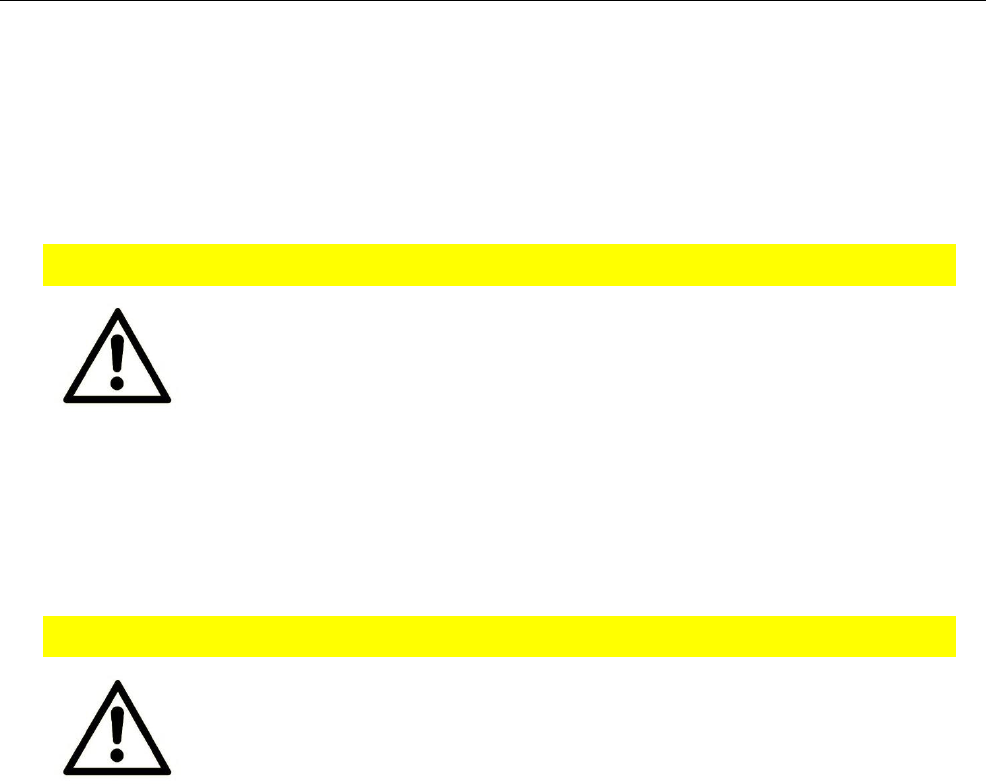
LSX
Assembly
33
5 Assembly
This section describes how to mount the LSX to a DIN rail, connect the power
supply and uninstall it again. Observe the instructions in the "Safety" section
of this manual, in particular the "Safety Instructions for Electrical Installation"
for that purpose unconditionally.
Caution!
Moisture and liquids from the environment may seep into
the interior of the device!
Fire hazard and damage of the product.
The device must not be used in wet or damp
environments, or in the direct vicinity of water. Install the
device at a dry location, protected from water spray.
Disconnect the power supply before you perform any work
on a device which may have been in contact with
moisture.
Caution!
The device could be destroyed if the wrong power supply
is used!
If the device is operated with a power supply that supplies
a voltage exceeding the permissible operating voltage, it
will be destroyed.
Make sure that you use the suitable power supply. Refer to
the Technical Data section for the proper voltage range.

Assembly
LSX
34
Mounting the device to the DIN rail
How to mount the LSX to a DIN rail:
1. Position the device at the DIN rail such that the upper snap-in hooks
engage behind the upper edge of the DIN rail.
2. Fold down the LSX perpendicular to the DIN rail until the lower,
flexible snap-in hook engages in the DIN rail.
The LSX is now readily mounted.
Connecting the power supply
The device has already been mounted to the DIN rail.
The power supply is connected and switched off.
1. Connect the ground lead of the power supply to the plug-in screw
terminal "GND".
2. Connect the plus pole of the power supply to the plug-in screw
terminal for the power supply.
3. Connect the screw terminal to the power supply socket.
The LSX is now connected to the power supply.
Disconnecting the power supply
The device is mounted to the DIN rail.
The power supply is connected and switched off.
1. Disconnect the power supply screw terminal.
The LSX is disconnected from the power supply.

LSX
Assembly
35
Removing the device from the DIN rail
How to uninstall the LSX from a DIN rail in a switch cabinet:
You will need a small flat-blade screwdriver.
The power supply of the switch cabinet is switched off and secured against
being switched on accidentally.
All connectors at the LSX are disconnected.
1. Insert the flat-blade screwdriver into the black lug at the bottom.
2. Move the flat-blade screwdriver up to move the lug down.
The plastic spring with the lower snap-in hook moves down.
3. While you hold the plastic spring apart with the lower snap-in hooks,
pull the LSX away from the DIN rail.
4. Un-hook the LSX and take it off perpendicularly to the DIN rail.
The LSX is now removed.
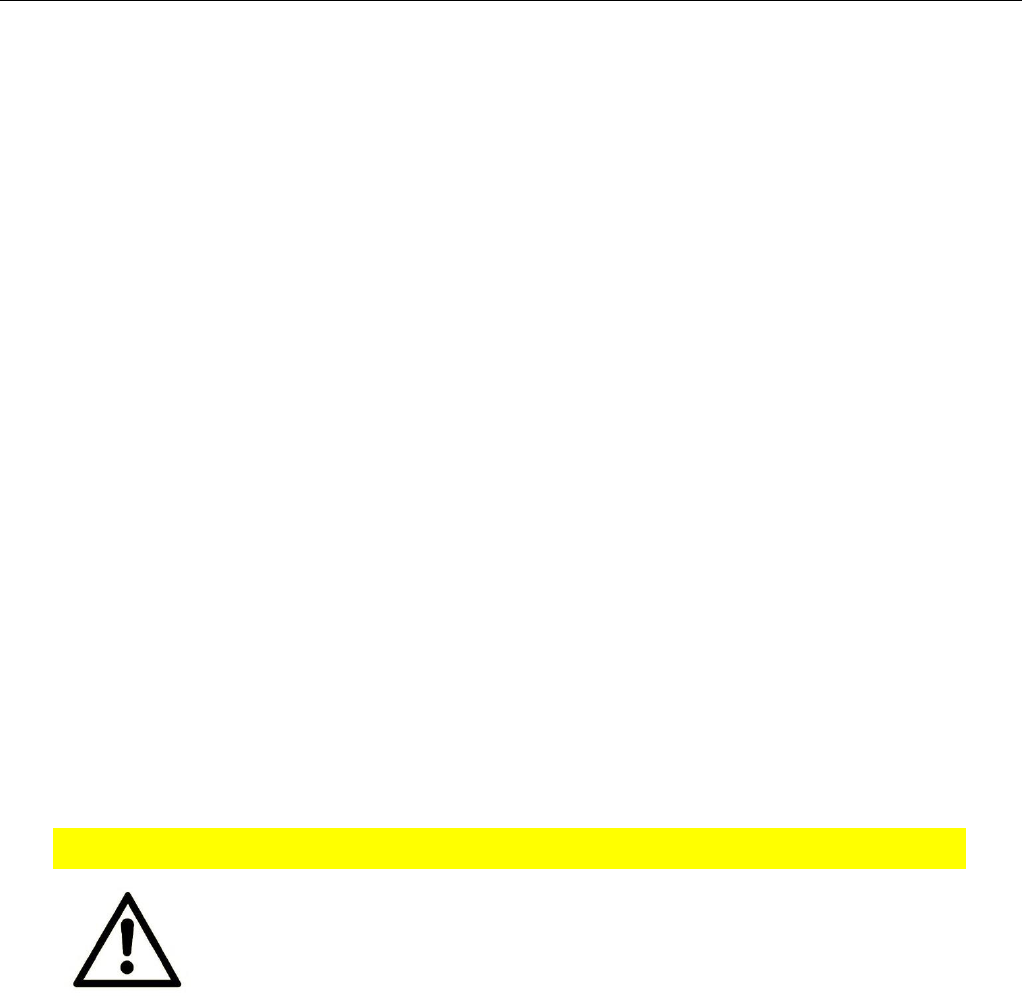
Maintenance, Repair and Troubleshooting
LSX
36
6 Maintenance, Repair and Troubleshooting
6.1 Maintenance
The product is maintenance-free and does not require special regular maintenance.
6.2 Troubleshooting
If a failure occurs during the operation of the product, you will find troubleshooting
tips in the "Knowledge Base" on our web site (http://www.insys-
icom.de/knowledge/). If you need further support, please contact your reseller or
INSYS icom. You can contact our support team via e-mail under support@insys-
tec.de.
6.3 Repair
Send defect devices with detailed failure description to the source of supply of your
device. If you have purchased the device directly from INSYS icom, send the device
to: INSYS MICROELECTRONICS GmbH, Hermann-Köhl-Str. 22, 93049 Regensburg.
Before dispatching the device:
Remove any inserted SIM cards.
Backup the configuration on the device and any other stored data if required.
Backup any sandbox applications running on the device.
Caution!
Short circuits and damage due to improper repairs and
modifications of products.
Fire hazard and damage of the product.
It is not permitted to open the product for repair or
modification exceeding the exchange of plug-in cards.

LSX
Waste Disposal
37
7 Waste Disposal
7.1 Repurchasing of Legacy Systems
According to the new WEEE guidelines, the repurchasing and recycling of legacy
systems for our clients is regulated as follows:
Please send those legacy systems to the following address, carriage prepaid:
Frankenberg-Metalle
Gaertnersleite 8
D-96450 Coburg
Germany
This regulation applies to all devices which were delivered after August 13, 2005.
Please consider possible stored passwords or security certificates
before disposing the device. It is recommended to block possible
existing access rights for the device (e.g. on your VPN server) and
reset the device to default settings (if possible), before passing it on or
disposing it.

Declaration of Conformity
LSX
38
8 Declaration of Conformity
Hereby, INSYS Microelectronics GmbH declares that herein described radio equip-
ment type is in compliance with Directives 1999/5/EC and 2011/65/EC. The full text
of the EC Declaration of Conformity is available under the following Internet ad-
dress:
www.insys-icom.com/manual
For compliance with CE conformity, it is also necessary to comply with DIN
EN62311. This controls the exposure of persons to electromagnetic fields.
Adherence to the following boundary condition is necessary for this:
Persons do not come closer to the antenna than 20 cm for a prolonged time
in normal use.
Only use antennas that we have been approved for the use with this product
in our evaluation procedure.

LSX
FCC Statement
39
9 FCC Statement
Note: Certain variants of this device comply with part 15 of the FCC Rules (this is
indicated by the FCC symbol on the label). Operation is subject to the following two
conditions: (1) This device may not cause harmful interference, and (2) this device
must accept any interference received, including interference that may cause unde-
sired operation.
Modifications not expressly approved by the manufacturer could void the user's au-
thority to operate the equipment under FCC rules.
Note: This equipment has been tested and found to comply with the limits for a
Class B digital device, pursuant to Part 15 of the FCC Rules. limits are designed to
provide reasonable protection against harmful interference in a residential installa-
tion. This equipment generates, uses and can radiate radio frequency energy and, if
not installed and used in accordance with the instructions, may cause harmful in-
terference to radio communications. However, there is no guarantee that interfer-
ence will not occur in a particular installation. If this equipment does cause harmful
interference to radio or television reception, which can be determined by turning
the equipment off and on, the user is encouraged to try to correct the interference
by one or more of the following measures:
• Reorient or relocate the receiving antenna.
• Increase the separation between the equipment and receiver.
• Connect the equipment into an outlet on a circuit different from that to which
the receiver is connected.
• Consult the dealer or an experienced radio/TV technician for help.

Export Restriction
LSX
40
10 Export Restriction
The chip sets for analogue modems and cellular radio adapters used by INSYS Mi-
croelectronics GmbH are subject to export restrictions as per US ECCN classifica-
tion (5A991).
Therefore, it is not allowed to export these communication devices into the follow-
ing countries (at the time when this publication has been issued): Cuba, Iran, North
Korea, Sudan, Syria
The currently effective country list can be found in section „Country Group E“ in
the document "Supplement No. 1 to Part 740" of the Export Administration Regula-
tions (EAR) (http://www.bis.doc.gov). Please contact the US authorities directly for
a special permit.
We want to make you aware that the US legislation may have an effect in Ger-
many. Amongst others, it may happen that US companies may be precluded from
supplying foreign violators of the EAR on the basis of US legislation.
Note
Export restriction!
Possible violation of export regulations.
This device uses encryption technology and is therefore
subject to export control as per German (AL classification
5A002) and European law (EG-DUAL-USE VO 428/2009).
The export from Germany requires a permission of the
Bundesamt für Wirtschaft und Ausfuhrkontrolle (Federal
Office of Economics and Export Control).
This device may contain components with US origin.
Possible export conditions as per US law (ECCN
classification) will be mentioned explicitly on receipts, if
possible, or can always be requested.

LSX
Tables and Diagrams
41
11 Tables and Diagrams
11.1 List of Tables
Table 1: Technical Information - ambient conditions .............................................. 16
Table 2: Technical Information - housing ................................................................ 16
Table 3: Technical Information – smart card holder ................................................ 16
Table 4: Technical Information – SIM card holder ................................................... 17
Table 5: Technical Information – Meter interface 1 (Meter 1) ................................. 17
Table 6: Terminal X3 – Meter interface 1 (Meter 1) ................................................. 17
Table 7: Technical Information – Meter interface 2 (Meter 2) ................................. 18
Table 8: Terminal X4 – Meter interface 2 (Meter 2) ................................................. 18
Table 9: Technical Information – Isolated outputs ................................................... 18
Table 10: Technical Information - Contact outputs ................................................. 19
Table 11: Terminal X5 – Digital outputs .................................................................. 19
Table 12: Terminal X5 – Permissible wire cross-sections ........................................ 19
Table 13: Technical Information – Isolated inputs ................................................... 19
Table 14: Technical Information - Contact inputs ................................................... 20
Table 15: Technical Information - Analogue inputs ................................................. 20
Table 16: Terminal X6 – Digital / analogue inputs ................................................... 20
Table 17: Terminal X6 – Permissible wire cross-sections ........................................ 20
Table 18: Technical Information – Relay outputs .................................................... 21
Table 19: Terminal X7 – Relay outputs .................................................................... 21
Table 20: Terminal X7 – Permissible wire cross-sections ........................................ 21
Table 21: Technical Information – GPS antenna connection ................................... 21
Table 22: Technical Information – Cellular antenna connection .............................. 21
Table 23: Technical Information – Serial interface 3 ............................................... 22
Table 24: Terminal X10 – Serial interface 3 ............................................................. 22
Table 25: Technical Information – WLAN antenna connection ............................... 22
Table 26: Technical Information – Ethernet interface .............................................. 23
Table 27: Technical Information – Power supply .................................................... 23
Table 28: Terminal X14 – Power supply .................................................................. 23
Table 29: Terminal X14 – Permissible wire cross-sections ...................................... 23
Table 30: Technical Information – GFI connection charging point 1 ....................... 24
Table 31: Technical Information – GFI connection charging point 1 – GFI_Preset .. 24
Table 32: Technical Information – GFI connection charging point 1 – GFI_Activate 24
Table 33: Technical Information – GFI connection charging point 1 – GFI_Status .. 24
Table 34: Technical Information – GFI connection charging point 1 – GFI_Welding
.......................................................................................................... 24
Table 35: Technical Information – GFI connection charging point 1 –
GFI_VoltageMonitor .......................................................................... 25

Tables and Diagrams
LSX
42
Table 36: Terminal X15 – GFI connection charging point 1 .................................... 25
Table 37: Technical Information – Connection charging point 1 – Interlock feedback
.......................................................................................................... 25
Table 38: Technical Information – Connection charging point 1 – Voltage monitor 26
Table 39: Technical Information – Connection charging point 1 – Proximity .......... 26
Table 40: Technical Information – Connection charging point 1 – Contactor ......... 26
Table 41: Technical Information – Connection charging point 1 – Operating current
trigger ................................................................................................ 26
Table 42: Technical Information – Connection charging point 1 – Interlock ........... 27
Table 43: Technical Information – Connection charging point 1 – PT1000 ............. 27
Table 44: Terminal X16 – Connection charging point 1 .......................................... 27
Table 45: Terminal X16 – Permissible wire cross-sections ...................................... 27
Table 46: Technical Information – GFI connection charging point 2 ....................... 28
Table 47: Technical Information – GFI connection charging point 2 – GFI_Preset .. 28
Table 48: Technical Information – GFI connection charging point 2 – GFI_Activate28
Table 49: Technical Information – GFI connection charging point 2 – GFI_Status .. 28
Table 50: Technical Information – GFI connection charging point 2 – GFI_Welding
.......................................................................................................... 28
Table 51: Technical Information – GFI connection charging point 2 –
GFI_VoltageMonitor .......................................................................... 29
Table 52: Terminal X17 – GFI connection charging point 2 .................................... 29
Table 53: Technical Information – Connection charging point 2 – Interlock feedback
.......................................................................................................... 29
Table 54: Technical Information – Connection charging point 2 – Voltage monitor 30
Table 55: Technical Information – Connection charging point 2 – Proximity .......... 30
Table 56: Technical Information – Connection charging point 2 – Contactor ......... 30
Table 57: Technical Information – Connection charging point 2 – Operating current
trigger ................................................................................................ 30
Table 58: Technical Information – Connection charging point 2 – Interlock ........... 31
Table 59: Technical Information – Connection charging point 2 – PT1000 ............. 31
Table 60: Terminal X18 – Connection charging point 2 .......................................... 31
Table 61: Terminal X18 – Permissible wire cross-sections ...................................... 31
Table 62: Meaning of the display elements ............................................................. 32
Table 63: Function of the reset key ......................................................................... 32
11.2 List of Diagrams
Figure 1: Terminal X3 – Meter interface 1 (Meter 1) (view on socket) .................... 17
Figure 2: Terminal X4 – Meter interface 2 (Meter 2) (view on socket) .................... 18
Figure 3: Terminal X10 – Serial interface 3 (view on socket) .................................. 22

LSX
Index
43
12 Index
Additional information ....................... 8
Alternative results ............................. 8
Assembly ......................................... 33
Breakdown ........................................ 9
Checkmark ........................................ 8
Connection ...................................... 33
Defects liability terms ........................ 6
DIN rail ............................................ 34
Electrical installation........................ 11
Environment .............................. 12, 33
Environmental Protection ................ 11
Explosive atmosphere ....................... 9
Formatting ......................................... 7
General safety instructions .............. 12
Housing ........................................... 13
Humidity .......................................... 16
Intended Use ..................................... 9
Interface .......................................... 13
IP rating ..................................... 16, 23
Key word ........................................... 7
Liquids ....................................... 12, 33
Marking ............................................. 7
Modification .............................. 12, 36
Moisture .................................... 12, 33
Open Source ................................... 14
Operating voltage ............................ 23
Overvoltage ..................................... 13
Overvoltage protection .................... 13
Permissible limit .............................. 10
Personnel ........................................ 10
Power consumption ........................ 23
Power LED ...................................... 31
Preface .............................................. 6
Prerequisites ...................................... 8
Qualification .................................... 10
Recycling ......................................... 37
Removal .......................................... 33
Repair ........................................ 12, 36
Repurchasing .................................. 37
Reset key ......................................... 32
Responsibilities of the operator ....... 10
RS232 .................................. 17, 18, 22
RS485 ........................................ 17, 18
Safety ................................................ 9
Short-cut ................................... 12, 36
Storage ............................................ 10
Switch cabinet................................. 34
Symbol .............................................. 7
Transport ......................................... 10
Usage ................................................ 9
Water spray ............................... 12, 33